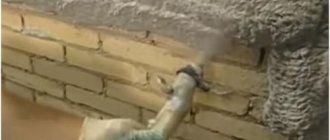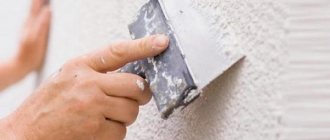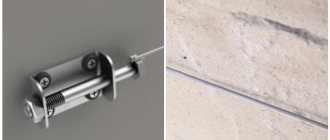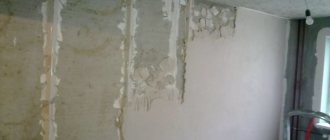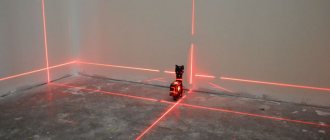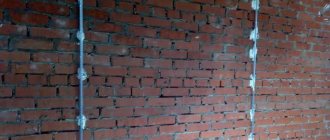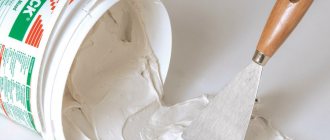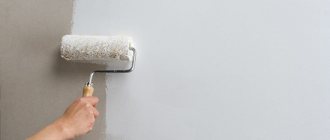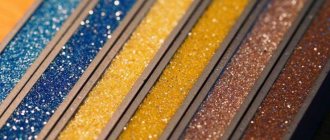Do I need to remove the beacons after plastering the walls?
Candidate of Sciences, site expert.
One of the most controversial issues in construction is whether it is necessary to remove beacons after plastering the walls. Professional finishers have two opposing opinions here. Some are categorically against dismantling the beacon guides, while others, on the contrary, recommend pulling them out and do this themselves all the time. Each opinion is based on many years of personal experience.
In such a situation, taking the side of one of the opposing camps is reckless. Therefore, this material analyzes the arguments of each side and, based on personal observations, makes its recommendations in a mild form, which the customer has the right to accept or reject.
What are beacons needed for?
Plasterers use elements called beacons to simplify leveling. Their function is to act as supporting elements of the surface, helping to form a flat plane. They are presented in the form of a metal profile with small holes; the length varies. Galvanized metal is used for production.
The advantages of use are: convenient installation and good efficiency. But the question of how to remove beacons after plastering without damaging the surface can be asked by both beginners and experienced finishers.
Application
Beacons are designed to simplify the work of leveling the surfaces of walls and floors and are made of thin metal or plastic. They are a three or six meter strip with a cross-section in the form of rails, a fastening surface and a perfectly flat side with a stiffening rib.
In the recent past, they were made from plaster mortar or wooden blocks. The disadvantage of the former was the long drying time and abrasion during surface leveling. This led to unevenness and depressions on the wall.
Beacons made of blocks can rot under a layer of plaster over time. Plastic representatives also have a number of disadvantages: increased flexibility and softness of the material. In the process of plastering walls, with little effort, it can usually change shape. As a result, the plane of the wall will be far from ideal. That is why the best option is to use metal products.
Before purchasing suitable beacons, you should find out what thickness the layer being built will be, since there is a limitation on the material thickness of 3 mm, 6 mm or 10 mm. It should be understood that if you reduce the thickness of the plaster layer by 1 cm, then the consumption of the finished mixture will also decrease to 10 liters per 1 sq. m.
Beacon installation
The quality of the finish depends on the correct installation of the beacons.
First of all, install the outer beacons on different sides of the wall, usually at a distance of 10-20 cm from the corner. The installation surface should be treated with water or primer. They should be installed perfectly and exactly level. The quality of the plastered surface will depend mainly on the correct installation of these beacons.
If there are depressions on the wall, then the outermost beacons must be recessed into the wall. Thus, it will be possible to reduce the thickness of the plaster layer. If you find a bulge, then it should be removed using a hammer and chisel or a hammer drill with an attachment.
Then, at two different horizontal levels, an extremely stretched thread is attached to them, along which the remaining intermediate beacons are set in increments of 50-80 cm.
It is better to carry out installation work together, as this will simplify the task and increase the quality of their installation.
When and why to delete
Those who believe that removal is necessary can name the following reasons:
- Profiles left in the wall over time cause the formation of rust, which begins to appear through the final coating and spoil the appearance of the walls.
- After completion of work, beacons can move away from the wall, which is why the plaster cracks and entire pieces fall off.
- If you plan to attach hanging furniture or paintings to the walls in the future, there is a risk that the fastening element will catch the left beacon. After this, the plaster may be damaged over a large area.
It is worth noting that unsightly rust stains can indeed appear on renovated walls. The reasons for their appearance may be:
- Poor quality of the material from which the profiles are made. If they are made in violation of technology, anti-corrosion protection is usually neglected. After a short period, such products begin to become covered with rust.
- When applying plaster, you can also accidentally damage the anti-corrosion coating. This happens even with high-quality products.
- The humidity in the room is always high. Under the influence of this factor, no protection against corrosion can withstand, and gradually rust begins to break through both the putty and the wallpaper.
The coating of lighthouses may differ in composition and thickness. If the product is of low quality, it can be accidentally damaged while working with the rule. A wall covering made of plaster needs regular moistening in the first days, so the corrosion process starts immediately after applying the working composition. Traces of rust will not appear immediately, but after a few days or weeks they will certainly appear through the plaster layer. In cases where the wall surface is tiled or thick wallpaper with a vinyl or non-woven layer is pasted, rust is unlikely to appear, but when painted with a water-based composition or wallpapered, their appearance will be spoiled.
If the profile moves away from the walls, the surface will certainly crack. Detachment of the beacon from the base can occur due to the following problems:
- The gap between the fasteners is too large.
- The walls are constantly subject to vibration.
- The plaster mortar shrinks.
- You can accidentally damage the integrity of the plaster layer while drilling by touching the metal with the drill.
The situations given as examples will not necessarily happen, but no one is immune from them. The decision about whether it is necessary to remove the beacons after plastering the walls is made by the owner of the premises where the repairs are being carried out. In this case, it is worth taking into account humidity, the material of the beacons, and other factors.
It is worth taking a closer look at the question of whether it is necessary to remove beacons made of plastic. They are not threatened by corrosion, but using the elements is much more difficult due to their greater flexibility. If the beacons are installed incorrectly, they will begin to sag under the influence of the rule, and the surface, even after leveling, will be defective.
How to dismantle beacons
Beacons must be removed in such a way that this procedure damages the coating as little as possible.
Immediately after finishing the plastering, you need to make cuts along both side edges of the beacons using a spatula and remove the mortar between them with a screwdriver - this will reduce the connection of the profile with the plaster layer and make dismantling easier. The ends of the beacons must also be cleaned of plaster.
The next day, a screwdriver is driven into the end of the lighthouse and bent away from the base. The tip of the profile is clamped across the axis with pliers, rotating which the beacon is wound around the jaws of the tool. Sometimes it is enough to simply pull the end of the profile away from the wall, and it will separate from the mortar on which it was sitting.
The furrow remaining after dismantling is filled with plaster mortar and rubbed.
When to remove beacons
You can leave plastic guides under the wallpaper on the walls of a bedroom or children's room. It is not necessary to remove elements if the moisture level in the room reaches 45-60%. Removal of metal beacons must be done where there is a significant likelihood of corrosion and damage.
Regardless of the material used, the guides should be removed until the plaster becomes strong. The reason is that it is much more difficult to remove elements from the frozen mixture. If you do not wait for the composition to partially acquire strength, then when removing metal or plastic products, it will significantly fall off.
Is it possible to leave beacons in plaster without consequences?
Since the main negative factor here is the likelihood of metal corrosion, some experts admit the possibility of leaving the beacons in the plaster, but after protecting them from oxidation.
After finishing plastering, it is proposed to cover the working surface of the beacons (sliding edge) with anti-corrosion paint.
The effectiveness of this procedure is ambiguous, as it depends on the quality of the paint and the correspondence of its characteristics to the place of application (cement mortar environment). In addition, when the paintwork wears out, including from exposure to chemicals, it must be renewed or replaced, and in the case of beacons this operation is not applicable.
Thus, painting steel beacons also does not eliminate the possibility of corrosion - after several years it is not excluded, and this factor will keep the homeowner in suspense.
In what cases should beacons be removed?
Most highly qualified craftsmen confidently prove that there are several reasons to remove metal profiles after the plaster has completely dried. The following were recognized as weighty arguments:
- The appearance of yellow spots on the wallpaper in the places where the beacon is installed.
- Deformation (deflection) of a profile or plastic product. This leads to the plaster cracking, moving away from the wall and pulling the wallpaper with it.
- The galvanized beacon is hidden under a layer of finishing putty, paint or wallpaper. In the process of fastening hanging furniture, audio or video equipment, the risk of damage to beacons by fasteners increases. As a result, significant damage to the plaster layer occurs.
Traces of corrosion (rust) can be seen quite often where, during the process of leveling the walls, the master decided not to remove the guides, hiding them under the finishing coating.
According to experienced finishers, it is mandatory to remove metal beacons. There are several reasons for making this decision:
- Low level of metal quality.
- Thin or uneven (with gaps) layer of zinc.
- Products created by unverified manufacturers.
- Galvanizing was performed using outdated equipment.
How to dismantle beacons
Beacons must be removed in such a way that this procedure damages the coating as little as possible.
Immediately after finishing the plastering, you need to make cuts along both side edges of the beacons using a spatula and remove the mortar between them with a screwdriver - this will reduce the connection of the profile with the plaster layer and make dismantling easier. The ends of the beacons must also be cleaned of plaster.
The next day, a screwdriver is driven into the end of the lighthouse and bent away from the base. The tip of the profile is clamped across the axis with pliers, rotating which the beacon is wound around the jaws of the tool. Sometimes it is enough to simply pull the end of the profile away from the wall, and it will separate from the mortar on which it was sitting.
The furrow remaining after dismantling is filled with plaster mortar and rubbed.
Peculiarities
By laying high-quality plaster along the beacons, you can achieve smooth and neat wall surfaces. Most finishing materials require ideal bases. Such coatings include thin paper wallpaper, various paints and varnishes, plastic and wooden panels, as well as different types of tiles. On uneven substrates, these materials will not adhere securely. Moreover, they can highlight wall imperfections, drawing unnecessary attention to them.
Currently, there are many ways to level walls. However, their coating with plaster remains the most common and popular. It is not difficult to carry out such work, especially if you use special beacons.
Why are beacons under plaster needed?
With the help of beacons, a contour is created for applying plaster, which serves to subsequently align the geometry of the walls. The correct installation of the beacons determines how smooth the walls will be after plastering. This is the most important stage of rough wall finishing.
Beacons are of the following types:
- Metal;
- Plastic;
- Reusable steel;
- Strings;
- By brand.
We will tell you in more detail about the advantages and disadvantages of each type of beacon.
Galvanized and aluminum beacons
Metal beacons can be called the most popular products. They are such due to their low price and popularity: such beacons can be found in any hardware store. These products have fairly simple instructions for use, which makes them popular for DIY repairs. Metal beacons have standard sizes of 6 and 10 millimeters. The choice of one of these options depends on the required amount of solution and deviations in the geometry of the room.
Metal beacons also have a number of disadvantages. For example, they should be carefully checked when purchasing for defects - the products may turn out to be crooked. You also need to make sure that they do not bend during transportation. When attaching such beacons to a wall, it is imperative to provide them with a rigid base.
Plastic beacons
Products made of high-strength plastic are lightweight, which makes them easy to install and remove. In terms of strength, plastic beacons are not inferior to the classic metal version, with the difference that when deformed, the plastic retains its original geometry. This fact allows them to be stored for a long time. Plastic beacons can be safely left under a layer of plaster without being removed, as they are not subject to rust.
Among the disadvantages of plastic beacons, it is worth noting their relatively high cost and unsuitability for external decoration in our climate (plastic becomes brittle in severe frost) and lack of resistance to strong impacts. In addition, plastic beacons can bend under the rule if they are not provided with a sufficiently strong base.
Reusable steel beacons
These products are the most durable among the entire range of beacons for plaster. These reusable devices are most often used by professionals due to their high cost and payback only on an industrial scale.
General information
For ease of work, beacons are often used, which are supporting elements of the surface and form an even vertical and horizontal plane. Previously, they were made directly from a solution directly on the surface to be treated. .
After some hardening, they were made into a rectangular shape, and then leveled and plastered. Then modern beacons came to replace them - metal perforated profiles of different lengths made of galvanized metal, the price of which is low.
Plaster profiles for leveling the surface
They are often called “quick leveling profiles” because they can be installed in a short time. With their help you can easily achieve an ideal surface condition.
What to do with beacons later
Before choosing a metal profile, first calculate the thickness of the plaster layer, since it is one for finishing walls, and another for the ceiling. After the work has been completed, the question will invariably arise: is it necessary to remove the beacons after plastering, since then there will again be a defect in the wall?
Most often the answer will be yes, as this is due to corrosion, which causes rusty streaks on the wall, spoiling the whole look. Although the lighthouse is made of galvanized steel, it will gradually begin to rust from aggressive environmental influences - moisture, air, etc. This happens due to the fact that during leveling and trimming the plaster layer, the galvanized layer is imperceptibly torn off from it.
Corrosion of leveling profiles
It should still be said that the lighthouse may not always rust, for example, in dry rooms there is a chance that this will not happen, but is it worth the risk? When rust does appear, you will have to rub it with white or paint it over, but it is not a fact that the problem will not happen again.
Therefore, when asked whether it is necessary to remove the beacons after plastering, many craftsmen answer in the affirmative, although for them there will be more work after this. The best option is to do it right away, while the plaster layer is just setting. With hardened plaster it will be a little more difficult, but not much. Below we will talk about exactly this method of removal.
Advice: remove the galvanized beacon from the wall to avoid unexpected troubles with the surface in the future.
Another positive aspect of removing beacons is that the plaster layer on the surface becomes uniform. Now you know for sure that you don’t need to expect any troubles from rust.
In the photo - rust has appeared on the wallpaper
Among them may be the following: when installing a switch and socket, a drill bit from a hammer drill can get into it and break a large piece of plaster out of the wall, in addition, a crack will appear on the wall due to vibration. And this will require new restoration work. So, tell me, is it necessary to remove the lighthouses after plastering? The answer is yes.
Technology
Below we will provide instructions for removing beacons from walls covered with gypsum and cement plaster.
By working on it, you can quickly and easily remove them with your own hands:
- Prepare your tools - pliers and a tool with which you can pry the lighthouse in the wall, for example, a plaster scraper.
- Determine where the guides are located. To do this, you can make marks on the ceiling in advance or use a magnet if they are visually hidden under the plaster.
Advice: don’t worry about the fact that you didn’t pull the beacons out of the damp wall, even after a month it will be easy to do if you know the technology.
- Take a stepladder or a strong chair and place it against the wall, since the beacon is installed from the ceiling, and using a scraper or other similar tool, remove some of the plaster from the top of the track and pry it up. Don't worry if some of the gypsum plaster comes off.
Start removing the profile from the wall
- Use pliers to grab the opened part of the lighthouse and slowly begin to pull it out. In this case, your movements should resemble twisting or winding.
Advice: you don’t need to pull the entire lighthouse out of the wall at once; it’s better to do it in parts, so that later there will be less plastering work.
- Continue removing 150-200 mm of the metal guide with pliers, gradually moving down the wall.
We remove the profile for leveling with pliers
- The removal process for cement plaster is essentially the same. It may be a little more difficult to work on this wall, but in the end you will succeed. It will take you about 1 minute to complete one guide.
- Seal the remaining areas on the wall with a suitable plaster mortar - gypsum or cement. The technology of work is the same as for conventional plastering.
Seal the areas from the guides with the necessary solution
- After removing the guides from the solution, you just need to throw them away, since they will not be used in the future. (See also the article Plastering rule - how to choose.)
Is it necessary to remove or remove beacons after plastering?
It is definitely necessary, even though they are galvanized. During the plastering process, galvanization is scratched and with exposure to moisture, the beacon will rust and the oxide will lick out through the wallpaper or paint, in the form of brown rusty stripes or spots. If the profile does not rust and the sellers convince you of this, then I will disappoint you - they oxidize and the gray oxide spots will still show through.
We dismantle the beacons using a hammer or hatchet, or you can simply pick it up with a spatula and pull it out along its entire length.
Therefore, we take out the beacons, do not reuse them, remove them and throw them away. I don’t think we are all so poor that we will skimp on lighthouses. It is allowed to leave profiles in places where there will be ceramic tiles or finishing stone, such as bathrooms, kitchen surfaces, floors or decorative parts of walls. In other cases we get it. It is advisable to remove beacons everywhere, because rust is unpredictable.
Why plaster beacons must be removed
I constantly hear debates - should I remove the beacons after plastering, or leave them in the wall? After all, galvanized lighthouses, in theory, should not rust. But no, and the galvanized beacons rust, and after a while rusty spots appear on the walls, and everything has to be redone again.
The thing is that metal beacons
are covered with a layer of galvanization, but during work, and specifically - leveling the plaster layer as a rule, the beacons receive damage, which will certainly rust over time, the only question is when.
The moisture from the cement mortar will be quite enough for rust.
, and even with gypsum solutions, beacons rust, although less often - the gypsum dries faster.
Thus, there are two ways out:
1) Remove the beacons the next day, when the plaster has already “set” but is still mobile enough to remove the beacons. After the procedure, we rub over the location of the beacons with the same plaster solution. It’s troublesome, but necessary, because fixing rusty walls is much more problematic.
2) If you do not want to pull out the beacons, then it is better to use plastic beacons. I don’t know about you, but I prefer metal beacons; somehow they didn’t work well with plastic ones. But these are minor things.
You can also use wooden beacons, although I don’t know if they are on sale. In Soviet times there were.
Of course, professional plasterers make beacons from mortar, but this requires experience, which many beginners simply do not have.
Source
